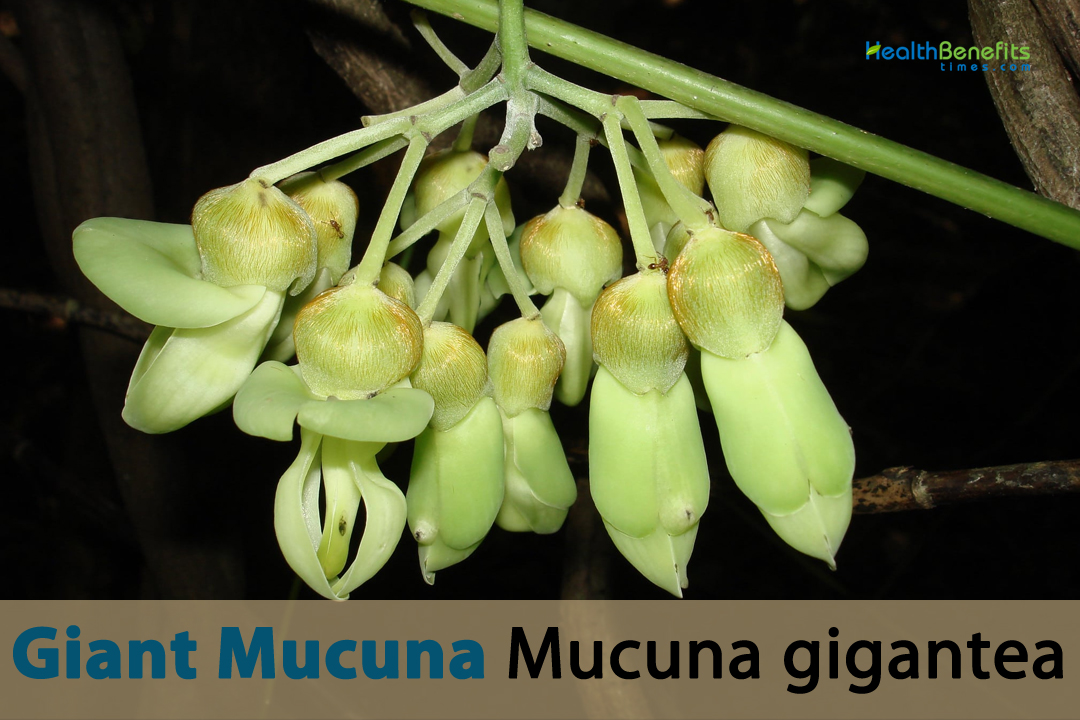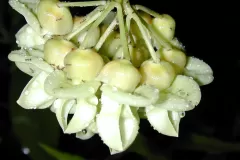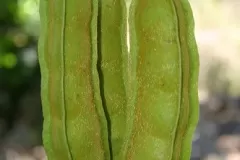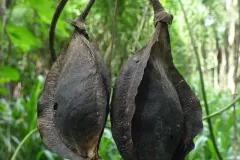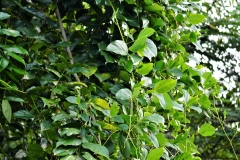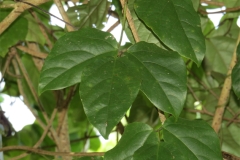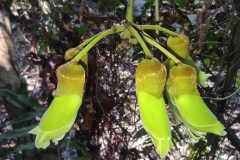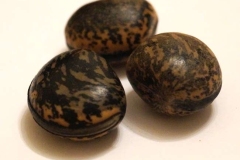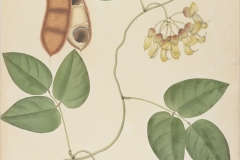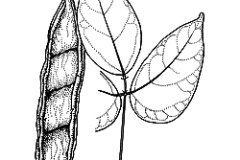| Giant Mucuna Quick Facts | |
|---|---|
| Name: | Giant Mucuna |
| Scientific Name: | Mucuna gigantea |
| Origin | Tropical southern Asia, Japan, Australia, Pacific Islands and sub-Saharan Africa |
| Colors | Dark purple to black |
| Shapes | Stiped pod, oblong or oblong-elliptical, densely covered with orange-brown bristle hairs |
| Health benefits | Neurological Support, Mood Enhancement, Cognitive Support Stress Reduction, Muscle Health, Sleep Regulation, Digestive Health, Bone Health, Cardiovascular Support |
| Name | Giant Mucuna |
|---|---|
| Scientific Name | Mucuna gigantea |
| Native | Tropical southern Asia, Japan, Australia, Pacific Islands and sub-Saharan Africa. In tropical Africa it is found from DR Congo to Kenya, Tanzania and Mozambique, also in Madagascar and other Indian Ocean islands |
| Common Names | Giant Mucuna, Giant Elephant Bean, Gigantic Mucuna, Giant Stizolobium, Big-seed Mucuna, Giant Wild Bean, Big Bean Vine, Large-seeded Velvet Bean, Giant Velvet Bean, Large Pod Mucuna, Giant Horse Eye Bean, Elephant Ear Mucuna, Huge-seed Velvet Bean, Big-eyed Mucuna, Giant Eyed Bean, Jumbo Velvet Bean, Giant Sea Bean, Big-seed Cowhage, Giant Fava Bean |
| Name in Other Languages | Afrikaans: Reus Mucuna, Groenblom-brandpeul Albanian: Mucuna e Madhe Amharic: G’tim Mucuna (ግጥሚ ሙኩና) Angika: Daitya Mukuna (दैत्य मुकुना) Arabic: Mukuna al-Amliqa (موكونا العملاقة), miqunat eimlaqa (ميقونة عملاقة) Armenian: Gigantakan Mukuna (Գիգանտական Մուկունա) Assamese: Daita Mukuna (দৈত্য মুকুনা) Azerbaijani: İri Mükuna, Giant Mukuna Bagheli: Daitya Mukuna (दैत्य मुकुना) Basque: Erraldoi Mucuna Belarusian: Higantskaya Mukuna (Гіганцкая мукуна) Bengali: Daita Mukuna (দৈত্য মুকুনা), Debodoot Mukuna (দেবদূত মুকুনা) Bhojpuri: Daitya Mukuna (दैत्य मुकुना) Bhutanese: Rgyal Ba Mucuna (རྒྱལ་བ་མུཀུན) Bosnian: Divlja mukuna Breton: Mucuna Meur (Big Mucuna) Bulgarian: Gigantska Mukuna (Гигантска мукуна) Catalan: Mucuna Gegant Chhattisgarhi: Daitya Mukuna (दैत्य मुकुना) Chinese: Jùdà Mùténg Dòu (巨大木藤豆), Ju li dou (巨 黧豆) Croatian: Divlja mukuna Czech: Obří Mucuna Danish: Kæmpe Mucuna Dogri: Wasee Mukuna (وسیع مکونا) Dutch: Reuzenmucuna English: Black-bean, Seabean, Velvet-bean, Elephant itch, Jade sting-pod, Burny bean Estonian: Hiid-mucuna Filipino: Higanteng Mukuna Finnish: Jätti-Mucuna, Giant Mucuna French: Mucuna géant, Liane à feuilles caduques, Liane cadoque, Liane caïman, Mort aux rats Gaddi: Vishal Mukuna (विशाल मुकुना) Galician: Mucuna Xigante Garhwali: Vishal Mukuna (विशाल मुकुना) Georgian: Ulamazesi Mukuna (ულამაზესი მუკუნა) German: Riesen-Mucuna Gondi: Daita Penda Greek: Gígantas Moukoúna (Γίγαντας Μουκούνα), Gigantiaía Moukoúna (Γιγαντιαία Μουκούνα) Gujarati: Dait Mukuna (દૈત મુકુના) Hausa: Mucuna Mai Girma Hebrew: Mukuna ha’Ankit (מוקונה הענקית) Hindi: Vishal Mukuna (विशाल मुकुना) Hungarian: Óriás Mukuna Icelandic: Risavaxiblóm (Giant Bean Flower) Igbo: Mucuna Ogaranya Indonesian: Mucuna Raksasa Irish: Mucúna Mór (Big Mucuna) Italian: Mucuna gigantea Japanese: Jaianto Mukuna (ジャイアントムクナ), Waniguchimodama (ワニグチモダマ) Kannada: Daitya Mookuna (ದೈತ್ಯ ಮೂಕುನ) Karbi: Dait Mukuna Kashmiri: Wasee Mukuna (وسیع مکونا) Kazakh: Uly Mukuna (Ұлы мукүна) Khasi: Ki Meiñ Mukuna Konkani: Daitya Mukuna (दैत्य मुकुना) Korean: Geodae Mukuna (거대 무쿠나) Kumaoni: Vishal Mukuna (विशाल मुकुना) Kutchi: Dait Mukuna (દૈત મુકુના) Kyrgyz: Örök Mukun (Өрөк мукун) Ladakhi: Wasee Mukuna (وسیع مکونا) Latvian: Milzīgais Mucuna Lepcha: Dait Mekuna Lithuanian: Didžioji Mucuna Luxembourgish: Rieseg Mucuna Macedonian: Gigantska Mukuna (Гигантска мукуна) Maithili: Daitya Mukuna (दैत्य मुकुना) Malay: Mukuna Gergasi Malayalam: Daiva Mukuna (ദൈവ മുകുന), Daitya Mukuna (ദൈത്യ മുകുന) Maltese: Mucuna Ġiganti Malvi: Vishal Mukuna (विशाल मुकुना) Manipuri: Daiti Mukuna (ꯈꯥꯡ ꯍꯦꯛꯐꯤ) Manx: Mucuna Mooar (Big Mucuna) Marathi: Daitya Mukuna (दैत्य मुकुना) Mizo: Tlangpui Mukuna Mongolian: Ikh Mukuna (Их Мукуна), Big Mukuna Nagamese: Daitya Mukuna (दैत्य मुकुना) Nepali: Daitya Mukuna, Giant Mukuna Norwegian: Gigantisk Mucuna Odia: Danaba Mukuna (ଦାନବ ମୁକୁନା) Persian: Mukuna-ye Azim (موکونای عظیم) Polish: Olbrzymia Mukuna Portuguese: Mucuna gigante Punjabi: Dait Mukuna (ਦੈਤ ਮੁਕੁਨਾ) Rajasthani: Vishal Mukuna (विशाल मुकुना) Romanian: Mucuna Gigant, Mucuna Gigantică Russian: Gigantskaya Mukuna (Гигантская мукуна), Mukuna gigantskaia (Мукуна гигантская) Sanskrit: Daitya Mukuna (दैत्य मुकुना) Santali: Dait Marang Scottish Gaelic: Mucuna Mòr (Big Mucuna) Serbian: Divlja mukuna (Дивља мукунa) Sesotho: Mucuna Ea Ntlokoa Sindhi: Waddo Mukuna (وڏو مڪونا) Sinhala: Dumra Mukuna (දුම්රා මුකුන්), Vishala Mukuna (විශාල මුකුන), Kana-pus-waela Slovenian: Divja mukuna Somali: Mucuna Awoow Spanish: Mucuna gigantea Swahili: Mucuna Mkubwa Swedish: Jätte-Mucuna Tajik: Mukunai Kalon (Мукунайи калон) Tamil: Periya Mukuna (பெரிய முகுன) Telugu: Daitya Mukuna (దైత్య ముకున) Thai: Mukuna Yak (มูคูนายักษ์), Krachiap (กระเจี๊ยบ), Ma mui (หมามุ่ย), Ma mui chang (หมามุ่ย ช้าง), Saba ling lai (สะบ้า ลิงลาย) Tibetan: Rgyal Ba Mucuna (རྒྱལ་བ་མུཀུན) Tulu: Daitya Mukuna (ದೈತ್ಯ ಮುಕುನ) Turkish: Dev Mucuna Ukrainian: Hihantska Mukuna (Гігантська мукуна) Urdu: Wasee Mukuna (وسیع مکونا) Uzbek: Katta Mukuna, Large Mukuna Vietnamese: Mucuna khổng lồ, Đậu mèo lớn, Đậu mèo to, Móc mèo lớn Welsh: Mucûn Mawr, Mawr Mucuna Xhosa: IMucuna Enkulu Yoruba: Mucuna Giga Zulu: UMucuna Othukile |
| Plant Growth Habit | Large, widespread, woody climbing plant |
| Growing Climates | Beach forest, monsoon forest, lowland and upland rain forest, coastal scrub, riverbanks, near water in woodland, forest edges, bush land, riverine and coastal moist forests |
| Soil | Giant Mucuna must have dirt that drains well. You can use a mix of gardening soil, peat moss, perlite, or sand. It likes soil that is slightly acidic to neutral. |
| Plant Size | Up to 30 meters (approximately 98 feet) or more under optimal conditions |
| Root | Develops strong anchor roots that originate from its base and extend into the soil. These anchor roots provide stability to the plant as it climbs and grows |
| Stem | Stems are flexible and able to twine around structures such as trees, poles, or trellises |
| Leaf | Alternate, trifoliate leaves with petioles up to 15 cm (6 in) long. The leaflets are ovate or elliptical, and up to 15 cm (6 in) long; the lateral leaflets are oblique, and all leaflets have rounded bases and apiculate tips |
| Flower | Each flower has a cup-shaped calyx with two lips, clad in fine greyish hairs. The corolla lobes are white, creamy-green or pale lilac; the standard is up to 3.5 cm (1.4 in) long, and the wings and keel slightly longer |
| Fruit Shape & Size | Stiped pod, oblong or oblong-elliptical, densely covered with orange-brown bristle hairs at first, becoming glabrous at maturity, up to 15 cm (6 in) long, each margin having two wings. |
| Fruit Color | Dark purple to black |
| Seed | Discoid, dark brown or densely mottled with rust brown or black, smooth, hilum extending around the seed-margin |
| Flavor/Aroma | Sweet, floral, musky, or even reminiscent of other scents like vanilla or citrus |
| Plant Parts Used | Seeds and leaves |
| Propagation | By seeds, stem cutting, Layering and Air layering |
| Lifespan | Several years to decades |
| Available forms |
|
| Health benefits |
|
Plant Description
Giant Mucuna is a large, common, woody climbing plant that can grow up to 30 meters (98 feet) or more in ideal circumstances. The plant grows in beach forest, monsoon forest, lowland and upland rain forest, coastal scrub, riverbanks, woodlands near water, bush land, forest edges, riverine and coastal moist forests, and lowland and highland rain forests. The plant likes dirt that drains well. You can use a mix of gardening soil, peat moss, perlite, or sand. It likes soil that is slightly acidic to neutral. The plant can also be grown in pots indoors or on decks, as long as it gets enough light, moisture, and room to grow.
Appropriate growing environment of Giant Mucuna
The Giant Mucuna has specific environmental preferences that are conducive to its growth and well-being. Here’s information about the appropriate growing environment for this plant:
- Climate: Giant Mucuna grows well in warm and subtropical areas. It likes warm weather and does well in places where there is constant sunlight and a moderate to high amount of humidity.
- Sunlight: This plant likes bright light that comes in from the side. During the hottest parts of the day, it does best when it gets limited sunlight or partial shade.
- Temperature: The Giant Mucuna likes it when it stays warm all the time. It grows best when the daytime temperature is between 70°F (21°C) and 85°F (29°C). Don’t let it get cold drafts or sudden drops in temperature.
- Soil: The Giant Mucuna must have dirt that drains well. You can use a mix of gardening soil, peat moss, perlite, or sand. It likes soil that is slightly acidic to neutral.
- Watering: Keep the Giant Mucuna’s soil about half dry and half wet. Before you water again, let the top inch (2.5 cm) of the dirt dry out. Too much water can cause plant rot, so make sure there is enough drainage.
- Humidity: Higher humidity levels are like the plant’s natural environment and help it grow best. If you are growing it inside, you can increase humidity by misting the leaves often or by using a humidity tray.
- Support and Climbing Structures: Because it grows by rising, the Giant Mucuna needs support structures to grow well. The plant will be able to climb and stick to trellises, poles, or other stable surfaces.
- Fertilization: Every 4 to 6 weeks during the growth season (spring and summer); use a balanced liquid fertilizer to feed the Giant Mucuna. During the dormant season (fall and winter), you should cut back on or stop feeding.
- Pruning: Cut the plant back every now and then to control its growth, encourage it to branch out, and get rid of any dead or dangerous growth. Pruning can help it keep its shape and grow thick leaves.
- Pests and Diseases: Keep an eye out for pests like aphids, mealy bugs, and spider mites. Check the plant often for signs of pests and treat it as needed. Make sure there is enough air flow to avoid fungal problems.
- Container Growing: The Giant Mucuna can also be grown in pots indoors or on porches, as long as it gets enough sun, moisture, and room to grow.
Roots
The Giant Mucuna grows strong anchor roots that go down into the ground from its base. As the plant grows and climbs, these support roots keep it steady. They hold the plant firmly to the ground and keep it from being blown away or moved by other things in the surroundings. The Giant Mucuna stands out because it has roots that grow in the air. These roots grow out from the nodes on the stem and out into the air. Aerial roots are an important part of how the plant climbs. They look for places to stick to, like trees or buildings. Once they are connected, these roots give the plant more support and security as it continues to grow up.
The water and nutrients from the dirt are taken up by the Giant Mucuna’s anchor roots. They have parts like root hairs that improve the surface area of the roots so that they can take in nutrients more efficiently. This gives the plant access to the vitamins and water it needs to grow and get stronger.
Stem
The stems are bendy and can wrap around things like trees, poles, or trellises. The plant can get more sunlight this way, which is important for photosynthesis and general growth. There are nodes along the branches where aerial roots grow out. These roots are a key part of how the tree grows. They look for objects to stick to, which gives the plant more stability and support as it grows up. Aerial roots may also have hooks or cells that stick to other things to help them stay in place. Stems are part of a plant’s circulatory system, which helps water, nutrients, and sugars get to all parts of the plant. The vascular tissues are made up of xylem, which moves water and minerals from the roots to the rest of the plant, and phloem, which moves sugars made by photosynthesis to parts of the plant where they are needed for growth and energy.
Leaves
Most leaves are grouped in pairs along the stems. This means that each leaf is at a different place on the stem. This helps the plant get the most light and keeps the leaves from getting too close together. The leaves are called compound leaves because each one is made up of several leaflets that are connected to a central stalk called the rachis. Each leaf has several leaflets that are generally paired up. Most of the time, the leaves are ovate (egg-shaped) or elliptical, and their tips are pointed. They may also have a smooth edge or have a few small cuts.
The leaves can be different colors, but most of the time they are green because of chlorophyll. Nodes are where leaves, branches, and flowers grow out of the main stem. This is where the leaves are connected to the stem. Nodes are also where the plant’s upper roots connect to the plant. In addition to photosynthesis, leaves also help with gas exchange and evaporation. They help keep the plant’s water balance in check and make it easier for gases like oxygen and carbon dioxide to move in and out of the plant.
Flower
Flowers are usually big, beautiful, and unique in how they look. They can be pendulous, which means they hang down from the plant, and they usually grow in groups called racemes. The flowers can be different colors, but most of the time they are pink, mauve, or purple. Pollinators can be drawn to the flowers by their bright colors. The petals, sepals, stamen, and pistil are all important parts of the flower that help it reproduce. Pollinators like bees, butterflies, and other animals, move pollen from one flower to another and help the plant get fertilized. The flowers of the Giant Mucuna are bright and showy, and they are placed and built in a way that makes them attractive to insects. Rain might not be able to stop blooming if the flower hangs down.
Fruit
The shape of most fruits is long and pod-like. They look like bean pods or legumes and can get quite big, which adds to the unique look of the plant. The pods have a tough skin on the outside that keeps the seeds inside safe. The walls of the pods can be thick or thin, based on how the plant has adapted to its environment and how it grows. There can be more than one seed in a pod. The fruits and seeds of the Giant Mucuna are eaten by many different animals. Some animals eat the seeds right off the plant, while others eat the pods or accidentally spread the seeds.
Seeds
Most of the time, the seeds are big, round, and fairly flat. They can be quite big, often bigger than bean seeds. The seed coat is the protected covering that goes around the seeds. This coat protects against physical damage, pathogens, and the effects of the surroundings. Most of the time, the seeds are in the pods of the plant. When the pods get big enough and split open, the seeds fall out. The seeds are important to the way an environment works. They can be eaten by animals, and they also help spread the seeds of plants to new places.
History
Giant Mucuna grows in warm Africa, southwestern and southern Asia, parts of Australia, and several Pacific islands. It lives in the Republic of Congo, Kenya, Tanzania, and Madagascar in Africa. In Asia, it lives in India, Myanmar, Malaysia, Thailand, and the Philippines. It also lives on islands in the Indian and Pacific Oceans. It lives in New Guinea and parts of Australia, including Western Australia, the Northern Territory, and New South Wales. It is mostly found in coastal scrubland. When it is found inland, as it is in Africa, it is usually near water, on riverbanks and lake shores, in scrub, at the edges of woods, and in woodland.
Giant Mucuna Image Gallery
Health benefits of Giant Mucuna
Giant Mucuna is a plant that has been traditionally used in various cultures for its potential health benefits. While scientific research is ongoing, here are some of the reported health benefits of Giant Mucuna:
1. Neurological Support
Giant Mucuna has natural compounds like L-DOPA (levodopa), which is a precursor to dopamine, a neurotransmitter that affects mood, drive, and pleasure. L-DOPA supplements are often used to keep the brain healthy and may help with conditions like Parkinson’s disease that are caused by a lack of dopamine.
2. Mood Enhancement
People think that Giant Mucuna can improve your happiness because of how it affects your dopamine levels. Some people use it to help them stay in a good mood, feel less stressed, and improve their general emotional health.
3. Motor Control
L-DOPA, which is found in Giant Mucuna, has been studied for its ability to improve motor control and reduce Parkinson’s disease symptoms. It may help people with shakes, stiffness, and bradykinesia (slow movement) feel better.
4. Antioxidant Properties
Giant Mucuna has antioxidants like flavonoids and phenolic substances that can help fight oxidative stress and stop free radicals from damaging cells. Antioxidants are important for good health in general and may help lower the chance of getting chronic diseases.
5. Anti-Inflammatory Effects
Some studies show that Giant Mucuna might be able to reduce inflammation. Chronic inflammation is linked to a number of health problems, such as heart disease, diabetes, and diseases that damage nerve cells.
6. Cognitive Support
L-DOPA is thought to be the reason why Giant Mucuna might help with memory and thinking. Dopamine is involved in brain processes like memory, learning, and paying attention. This makes Giant Mucuna an area of interest for research into brain health.
7. Stress Reduction
Some people think that the adaptogenic features of Giant Mucuna could help the body deal with stress better. Adaptogens are substances that may help control how the body reacts to stressors, leading to a more balanced reaction to stress.
8. Hormonal Balance
Some studies show that Giant Mucuna could affect hormone levels, which could help keep hormones in order in some cases. But we need to do more study to fully understand this part.
9. Anti-Anxiety Effects
Giant Mucuna may be able to help control anxiety and make you feel more relaxed because it may help stabilize your mood and reduce your anxiety.
10. Energy and Vitality
Giant Mucuna may help improve energy and stamina because it contains natural compounds like L-DOPA. L-DOPA helps make dopamine, a chemical that gives you energy and makes you want to do things.
11. Muscle Health
Research shows that the L-DOPA in Giant Mucuna might be good for the health and strength of muscles. It could help muscles heal and grow, so players and people who want to keep their muscle mass might be interested in it.
12. Libido Enhancement
L-DOPA changes dopamine, which is involved in the brain’s pleasure and reward circuits. Giant Mucuna has been used for a long time as an aphrodisiac and to boost sexual drive and performance.
13. Sleep Regulation
Dopamine also helps control how often you sleep. Giant Mucuna’s ability to change dopamine levels could help people sleep better and control their sleep-wake patterns.
14. Anti-Parkinsonian Effects
Because giant mucuna has a lot of L-DOPA, it is being looked at as a natural way to treat Parkinson’s disease signs. L-DOPA is often used to treat Parkinson’s disease because it can boost the amount of dopamine in the brain.
15. Antidepressant Properties
Some study suggests that Giant Mucuna’s effects on dopamine could help explain why it might work as a natural antidepressant. It might help people with mild to moderate sadness feel better.
16. Nootropic Potential
Nootropics are chemicals that improve the way the brain works. Giant Mucuna has been looked at as a possible nootropic because it affects dopamine and might help nerve cells.
17. Antimicrobial Properties
Some tests have shown that extracts of Giant Mucuna may be able to kill germs. These qualities could help the immune system work well and make it less likely that someone will get sick.
18. Digestive Health
Giant Mucuna has been used in traditional medicine to help with gut health. It might help with digestion, ease heartburn, and make the stomach feel better.
19. Anti-aging Effects
Giant Mucuna’s antioxidant content may help it slow down aging by lowering oxidative stress and cellular damage, both of which are linked to aging and age-related diseases.
20. Bone Health
Some study shows that the natural chemicals in Giant Mucuna might be good for bone health. It might help with bone density and the general health of the skeleton.
21. Cardiovascular Support
The antioxidants in Giant Mucuna may be good for heart health because they reduce toxic stress and help blood vessels work well.
Different uses of Giant Mucuna
Giant Mucuna has various potential uses due to its unique characteristics. While some of these uses are well-documented, others are still being explored. Here are different uses of Giant Mucuna
- Agricultural Use: Many types of Mucuna, including Giant Mucuna, are known for their ability to fix nitrogen. This means that they can change the nitrogen in the air into a form that is good for the soil. This makes them useful for improving soil fertility and promoting sustainable farming.
- Cover Crop: Mucuna gigantea can be used in agriculture as a cover crop. It grows quickly and has a lot of leaves, which help stop soil loss, improve soil structure, and stop weeds from growing. This is good for managing land in a sustainable way.
- Green Manure: Mucuna gigantea works as a green manure when it is tilled back into the soil. It adds organic matter and nutrients to the soil. This makes the land healthier, more fertile, and more productive overall.
- Natural Pesticide: Some types of Mucuna have been shown to kill insects, which could be a natural way to get rid of pests in agriculture. Extracts from the plant have been looked at to see if they could keep certain pests away or get rid of them.
- Forage: In places where Giant Mucuna grows, the leaves and other parts of the plant could be used to feed animals. This can help feed and take care of animals.
- Soil Improvement: Giant Mucuna’s deep roots help keep the soil from getting too hard, let more water through, and break up hard layers, all of which are good for the soil’s health as a whole.
- Ecological Restoration: Mucuna species are useful for reforestation, ecological repair, and land reclamation projects because they grow quickly and can fix nitrogen in the soil.
- Biofuel and Biomass: Giant Mucuna could be used to make biofuels because it grows quickly and can produce a lot of waste. Its plant matter, or biomass, could be turned into bioethanol or biogas, which is both clean energy sources.
- Textile and Craft: In some countries, the fibers from the pods and stems of Giant Mucuna have been used to make clothes, crafts, and traditional items.
- Folklore and Myths: Local folklore, myths, and stories often include plants like Giant Mucuna. This adds to cultural stories and customs.
- Wildlife Habitat: Giant Mucuna’s dense growth and leaves can provide cover and food for different kinds of wildlife, which helps local ecosystems.
- Ornamental Plant: Giant Mucuna might be grown as a decorative plant in some places because it has pretty flowers and looks different from other plants.
- Erosion Control: Giant Mucuna’s large root system helps support soil and stop soil erosion. This makes it useful for stabilizing slopes and preserving soil.
- Green Cover for Infrastructure: Giant Mucuna grows quickly, so it can be used to quickly cover building sites, road banks, and other infrastructure projects with greenery.
Side effects of Giant Mucuna
There is limited information available regarding the side effects of Giant Mucuna. However, it’s important to note that Mucuna species, in general, contain bioactive compounds that can have both beneficial effects and potential side effects. Here are some considerations:
- L-DOPA Content: L-DOPA (levodopa), which is found in Mucuna plants like Giant Mucuna, is turned into dopamine in the body. L-DOPA is used to treat medical conditions like Parkinson’s disease, but if you take too much of it without medical supervision, your dopamine levels could rise, which could cause side effects linked to too much dopamine.
- Interaction with Medications: L-DOPA can have an effect on many different kinds of drugs, including those used to treat sadness, psychosis, and high blood pressure. Before using Mucuna gigantea or similar goods, talk to your doctor if you are taking any prescription drugs, especially those that affect neurotransmitters.
- Gastrointestinal Distress: Some people who eat Mucuna gigantea or goods made from it might get stomach problems like nausea, vomiting, or an upset stomach.
- Allergic Reactions: Giant Mucuna could cause allergic reactions in people who are sensitive to plants, just like any other plant. Before using products with Mucuna extracts, it is suggested to do a patch test.
- Toxic Compounds: Raw Mucuna seeds can have compounds in them that are poisonous, so they need to be soaked and cooked to get rid of these compounds. If the seeds aren’t prepared well enough, bad things could happen.
- Cognitive and Mood Effects: Because Giant Mucuna affects dopamine levels, taking too much of it could change your mood and brain processes. Some people might feel anxious, restless, or have other problems with their mood.
- Blood Pressure: The blood pressure can be affected by L-DOPA. People with high or low blood pressure should be careful when using Giant Mucuna goods and talk to a doctor first.
- Pregnancy and Breastfeeding: Women who are pregnant or breastfeeding should not use Giant Mucuna products because they might have effects on the growth of the baby or fetus that are not known.
- Individual Variations: Herbal vitamins can have different effects on different people, and each person’s sensitivity can be different. It’s smart to start with a small amount and see how your body reacts.
- Quality and Purity: Products from Giant Mucuna can have a wide range of quality and clarity. Make sure you buy goods from reputable places to reduce the chance that they are contaminated or changed in some way.
References:
http://www.theplantlist.org/tpl1.1/record/ild-2852
https://www.itis.gov/servlet/SingleRpt/SingleRpt?search_topic=TSN&search_value=503879#null
https://en.wikipedia.org/wiki/Mucuna_gigantea
https://uses.plantnet-project.org/en/Mucuna_gigantea_(PROTA)
http://www.flowersofindia.net/catalog/slides/Sea%20Bean.html
https://tropical.theferns.info/viewtropical.php?id=Mucuna+gigantea
https://bie.ala.org.au/species/https://id.biodiversity.org.au/node/apni/2887169
https://plants.usda.gov/home/plantProfile?symbol=MUGI


